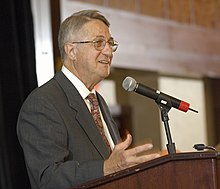Robert W. Gore
| Robert W. Gore | |
|---|---|

|
|
| Born |
April 15, 1937 Salt Lake City, Utah |
| Residence | Newark, Delaware, U.S. |
| Fields | Chemical Engineering |
| Institutions | W. L. Gore & Associates |
| Alma mater | University of Delaware, University of Minnesota |
 |
|
|
|
Robert W. "Bob" Gore (born April 15, 1937) is an American engineer and scientist, inventor and businessman. Robert Gore has led his family's company, W. L. Gore & Associates, in developing applications of polytetrafluoroethylene (PTFE) ranging from computer cables to medical equipment to the outer layer of space suits. His most significant breakthrough is likely the invention of Gore-Tex, a waterproof/breathable fabric popularly known for its use in sporting and outdoor gear.
Robert Gore was born in Salt Lake City, Utah on April 15, 1937, to Wilbert "Bill" and Genevieve "Vieve" Gore. His family relocated near Newark, Delaware in 1950, to be near his father's work at the DuPont Experimental Station in Wilmington, Delaware. The Gore family stayed with friends for several months while Bob's father built their house. Bob attended school in Newark beginning in eighth grade.
Robert Gore graduated with his bachelor's degree in chemical engineering at the University of Delaware in 1959. With his wife and son, he moved to University Village in September 1959 to attend graduate school. He completed his graduate studies at the University of Minnesota, earning an M.S. and then a Ph.D. in Chemical Engineering in 1963.
While Robert's father Bill Gore was working for DuPont, he was also experimenting at home with DuPont materials such as Teflon Polytetrafluoroethylene (Teflon PTFE). He wanted to insulate electrical wires using PTFE, but attempts to coat wire with powdered PTFE did not produce a consistent coating. In April 1957, while Bob was still a sophomore at Delaware, Bill showed him around his home lab and explained the problem he was having.
Bob suggested surrounding the wire with a different form of PTFE, a white tape that was already of uniform thickness. His father expected that the PTFE tape would not stick to the wire, but he tried the idea, and it worked. Wires were laid between layers of PTFE tape and sent through a grooved calendar roll, then heated to melt the tape into a coherent coating. The result was a PTFE-insulated ribbon cable containing multiple copper conductors, later called "Multi-Tet Cable".
...
Wikipedia
